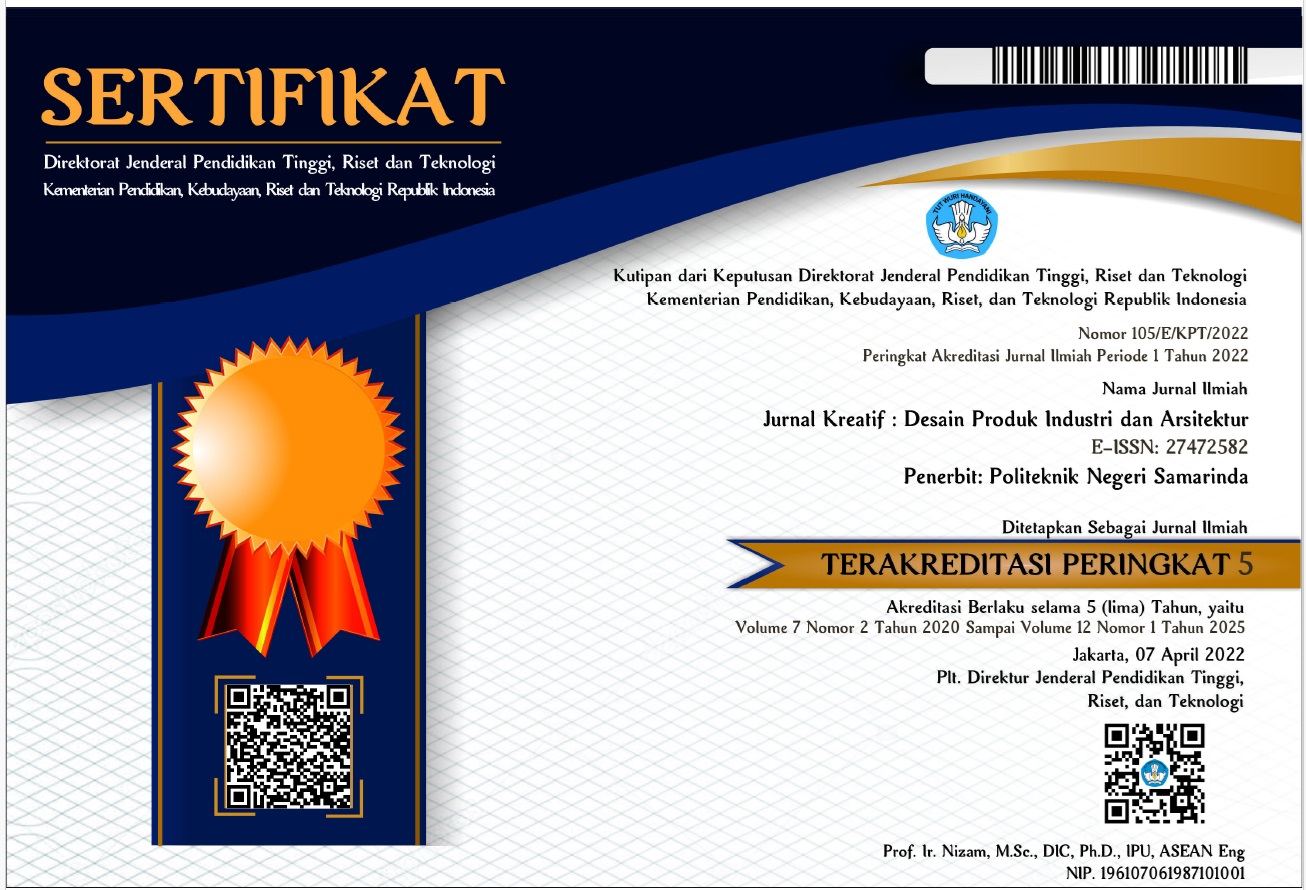KAJIAN SEMIOTIKA DESAIN PRODUK “HUG SALT AND PEPPER SHAKER”, KARYA DESAINER ALBERTO MANTILLA
 Abstract views: 884
,
Abstract views: 884
,
 pdf downloads: 456
pdf downloads: 456
Abstract
Abstrak
Koentjaraningrat (2002) melihat bahwa kebudayaan memiliki wujud sebagai 1) ide atau gagasan, 2) sebagai aktivitas atau tindakan, dan 3) sebagai benda hasil karya manusia. Hal tersebut berarti suatu artefak sebagai wujud benda dari kebudayaan dapat mencerminkan berbagai aspek tak benda yang berada disekitar lingkungan penciptaan artefak tersebut. Desain Produk “Hug Salt and Pepper Shaker” karya desainer Alberto Mantilla menarik untuk dikaji karena menampilkan ciri-ciri visual simbol-simbol ideologi Timur padahal kebangsaan desainer dan lokus penciptaannya berada di dunia Barat. Dalam tulisan ini akan dikaji makna produk tersebut melalui intrepertasi semiotis menggunakan kombinasi metode dan teori yang dikembangkan oleh Roland Barthes, Mongin-Ferdinand de Saussure dan Charles Sanders Peirce. Tahapan analisa akan dimulai dengan melakukan klasifikasi tanda berikut intrepretasi maknanya, yang selanjutnya akan digali pula makna dalam relasi antar tandanya.
Melalui serangkaian kajian terebut dapat disimpulkan bahwa produk itu secara visual memiliki makna konotatif mengenai persahabatan, keharmonisan hubungan antar individu, kesetaraan dan penerimaan satu sama lain; dan ada mitos yang dipercayai oleh sang desainer bahwa ideologi Taoisme (Yin & Yang) adalah ideologi yang tepat untuk mewujudkan hal tersebut.
Kata kunci : Semiotika, Salt & Pepper, Yin & Yang, Taoisme
Abstract
Koentjaraningrat (2002) suggested that cultures can be seen as 1) ideas, 2) activities, and 3) artefacts. It is can be concluded that artefacts as tangible aspects of cultures can be used to predict a lot of intangible aspects of cultures that surrounds a community on which the cultures grow. The “Hug Salt and Pepper Shaker” designed Alberto Mantilla is quite interesting to be analyzed. The product shows visual traits of ancient Eastern Ideology symbol, while the desainer grew in the western culture.
The paper are going to do series of analysis using a combination of semiotic method and theory that is propossed by Roland Barthes, Mongin-Ferdinand de Saussure dan Charles Sanders Peirce. Started with doing several sign classification and its meaning, followed by analysis on the meaning of the relations that is formed between the signs.
Through the analysis can be concluded that visual traits on the product has conotative meaning of friendship, harmony, equality and acceptance. On the second level of meanings it can be seen that the designer believed on mith, that Taoism is the most suitable ideology to make those condition comes true.
Keywords : Semiotic, Salt & Pepper, Yin & Yang, Taoism
Downloads
References
Budiman, Kris. 1999. Kosa Semiotika. Yogyakarta :LKiS.
Danesi, Marcel. 2007. The Quest For Meaning: A Guide To Semiotic Theory And Practice. Toronto: University of Toronto Press.
Darmaprawira W. A, Sulasmi. 2002. Warna, Teori dan Kreativitas Penggunaannya. Bandung : Penerbit ITB.
Durlabhji, Subhash. 2004. The Tao of Organization Behaviour. Journal of Business Ethics, Vol 52. Netherlands: Kluwer Academic Publishers. (diunduh dari www.springerlink.com, 8 Maret 2011).
Johansen, Jorgen Dines & Larsen, Sven Erik. 2002. Signs In Use. London: Routledge.
Koentjaraningrat. 1976. Manusia dan Kebudayaan di Indonesia. Jakarta : Penerbit Djambatan.
Leborg, Christian. 2004. Visual Grammar. New York: Princeton Architectural Press.
Noth, Winfried. 1995. Handbook of Semiotics. Bloomington: Indiana University Press.
Parrinder, Geoffrey. 2005. Teologi Seksual. Yogyakarta : LKiS.
Authors who publish with this journal agree to the following terms:
- Copyright on any article is retained by the author(s).
- The author grants the journal, right of first publication with the work simultaneously licensed under a Creative Commons Attribution License that allows others to share the work with an acknowledgment of the work’s authorship and initial publication in this journal.
- Authors are able to enter into separate, additional contractual arrangements for the non-exclusive distribution of the journal’s published version of the work (e.g., post it to an institutional repository or publish it in a book), with an acknowledgment of its initial publication in this journal.
- Authors are permitted and encouraged to post their work online (e.g., in institutional repositories or on their website) prior to and during the submission process, as it can lead to productive exchanges, as well as earlier and greater citation of published work.
- The article and any associated published material is distributed under the Creative Commons Attribution-ShareAlike 4.0 International License













